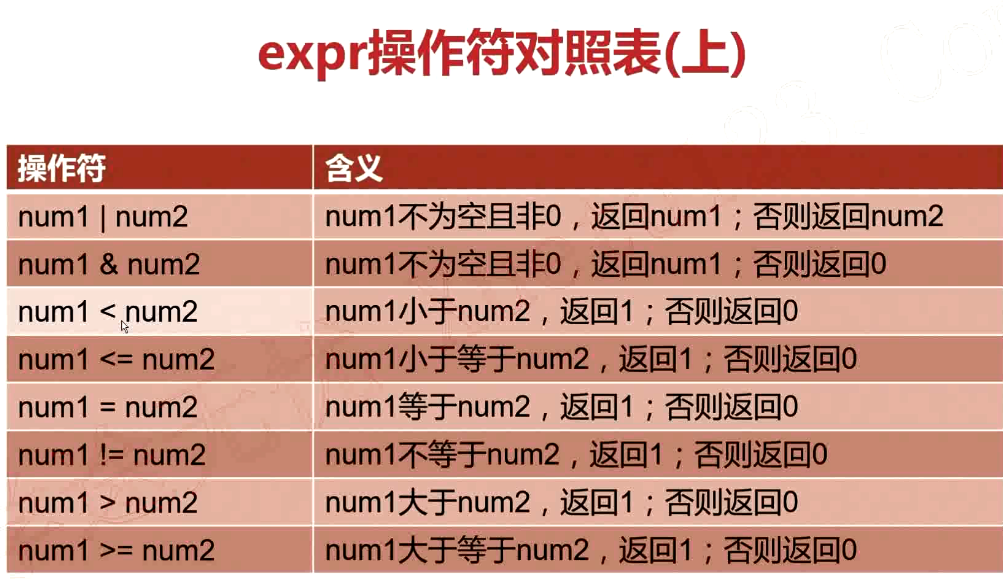1.shell编程之变量的高级用法
1.1.变量替换
变量替换的六种形式

实例:非贪婪和贪婪的区别
从头部删除
[root@VM_0_9_centos shell_learn]# var_1="i love you,do you love me"
[root@VM_0_9_centos shell_learn]# echo $var_1
i love you,do you love me
[root@VM_0_9_centos shell_learn]# var1=${var_1#*ov}
[root@VM_0_9_centos shell_learn]# echo $var1
e you,do you love me
[root@VM_0_9_centos shell_learn]# var2=${var_1##*ov}
[root@VM_0_9_centos shell_learn]# echo $var2
e me
[root@VM_0_9_centos shell_learn]#
从尾部删除
[root@VM_0_9_centos shell_learn]# var_1="i love you,do you love me"
[root@VM_0_9_centos shell_learn]# echo $var_1
i love you,do you love me
[root@VM_0_9_centos shell_learn]# var3=${var_1%ov*}
[root@VM_0_9_centos shell_learn]# echo $var3
i love you,do you l
[root@VM_0_9_centos shell_learn]# var4=${var_1%%ov*}
[root@VM_0_9_centos shell_learn]# echo $var4
i l
[root@VM_0_9_centos shell_learn]#
字符串替换,把bin替换成大写的BIN,单斜线和双斜线的区别
[root@VM_0_9_centos shell_learn]# echo $PATH
/usr/local/sbin:/usr/local/bin:/usr/sbin:/usr/bin:/root/bin
[root@VM_0_9_centos shell_learn]#
[root@VM_0_9_centos shell_learn]# var5=${PATH/bin/BIN}
[root@VM_0_9_centos shell_learn]# echo $var5
/usr/local/sBIN:/usr/local/bin:/usr/sbin:/usr/bin:/root/bin
[root@VM_0_9_centos shell_learn]#
[root@VM_0_9_centos shell_learn]# var6=${PATH//bin//BIN}
[root@VM_0_9_centos shell_learn]# echo $var6
/usr/local/s/BIN:/usr/local//BIN:/usr/s/BIN:/usr//BIN:/root//BIN
[root@VM_0_9_centos shell_learn]#
1.2.字符串处理
计算字符串长度
方法一
${#string}
方法二
string有空格,则必须加双引号
expr length "$string"
实例
[root@VM_0_9_centos shell_learn]# var1="hello world"
[root@VM_0_9_centos shell_learn]# len=${#var1}
[root@VM_0_9_centos shell_learn]# echo $len
11
[root@VM_0_9_centos shell_learn]# len2=`expr length "$var1"`
[root@VM_0_9_centos shell_learn]# echo $len2
11
[root@VM_0_9_centos shell_learn]#
获取子串在字符串中的索引位置
expr index $string $substring
实例
[root@VM_0_9_centos shell_learn]# var1="quickstart is a app"
[root@VM_0_9_centos shell_learn]# index=`expr index "$var1" start`
[root@VM_0_9_centos shell_learn]# echo $index
6
[root@VM_0_9_centos shell_learn]# index2=`expr index "$var1" uniq`
[root@VM_0_9_centos shell_learn]# echo $index2
1
[root@VM_0_9_centos shell_learn]# index3=`expr index "$var1" cnk`
[root@VM_0_9_centos shell_learn]# echo $index3
4
[root@VM_0_9_centos shell_learn]#
会把子串分割成一个一个字符,index是最先找到的那个字符的位置。
计算子串长度
expr match $string substr
实例
[root@VM_0_9_centos shell_learn]# var1="quickstart is a app"
[root@VM_0_9_centos shell_learn]# len=`expr match "$var1" quic`
[root@VM_0_9_centos shell_learn]# echo $len
4
[root@VM_0_9_centos shell_learn]# len=`expr match "$var1" app`
[root@VM_0_9_centos shell_learn]# echo $len
0
[root@VM_0_9_centos shell_learn]# len=`expr match "$var1" quic.*`
[root@VM_0_9_centos shell_learn]# echo $len
19
[root@VM_0_9_centos shell_learn]#
必须从开头匹配才可以
抽取子串

实例
[root@VM_0_9_centos shell_learn]# var1="kafka hadoop yarn mapreduce"
[root@VM_0_9_centos shell_learn]# sub1=${var1:10}
[root@VM_0_9_centos shell_learn]# echo $sub1
op yarn mapreduce
[root@VM_0_9_centos shell_learn]# sub2=${var1:10:5}
[root@VM_0_9_centos shell_learn]# echo $sub2
op ya
[root@VM_0_9_centos shell_learn]# sub3=${var1: -5}
[root@VM_0_9_centos shell_learn]# echo $sub3
educe
[root@VM_0_9_centos shell_learn]# sub4=${var1:(-6)}
[root@VM_0_9_centos shell_learn]# echo $sub4
reduce
[root@VM_0_9_centos shell_learn]# sub5=${var1: -5:3}
[root@VM_0_9_centos shell_learn]# echo $sub5
edu
[root@VM_0_9_centos shell_learn]# sub6=`expr substr "$var1" 10 5`
[root@VM_0_9_centos shell_learn]# echo $sub6
oop y
[root@VM_0_9_centos shell_learn]#
注意:使用expr索引是从1开始计算,使用${string:position},索引从0开始计算。
1.3.字符串处理完整脚本

思路分析
1.将不同的功能模块划分,并编写函数
function print_tips
function len_of_string
function del_hadoop
function rep_hadoop_mapreduce_first
function rep_hadoop_maapreduce_all 2.实现第一步所定义的功能函数 3.程序主流程的设计
vim example.sh
#!/bin/bash string="Bigdata process framework is Hadoop,Hadoop is an open source project" function print_tips
{
echo "******************************"
echo "(1)打印string长度"
echo "(2)删除字符串中所有的Hadoop"
echo "(3)替换第一个Hadoop为Mapreduce"
echo "(4)替换全部Hadoop为Mapreduce"
echo "*******************************"
} function len_of_string
{
echo "${#string}"
} function del_hadoop
{
echo "${string//Hadoop/}"
} function rep_hadoop_mapreduce_first
{
echo "${string/Hadoop/Mapreduce}"
} function rep_hadoop_mapreduce_all
{
echo "${string//Hadoop/Mapreduce}"
} while true
do
echo "[string=$string]"
echo
print_tips
read -p "Pls input your choice(1|2|3|4|q|Q): " choice case $choice in
1)
len_of_string
;;
2)
del_hadoop
;;
3)
rep_hadoop_mapreduce_first
;;
4)
rep_hadoop_mapreduce_all
;;
q|Q)
exit
;;
*)
echo "Error,input only in {1|2|3|4|q|Q|}"
;;
esac
done
sh example.sh

1.4.命令替换
语法格式
方法一:
`command` 方法二:
$(command)
实例一:获取系统所有的用户并输出
cat /etc/passwd | cut -d ":" -f 1
vim example2.sh
#!/bin/bash
# index=1
for user in `cat /etc/passwd | cut -d ":" -f 1`
do
echo "This is $index user: $user"
index=$(($index+1)) done
结果

实例二:根据当前当前时间计算今年和明年
$(());两个括号主要用来进行整数运算
[root@VM_0_9_centos shell_learn]# date
Wed Jun 26 21:58:04 CST 2019
[root@VM_0_9_centos shell_learn]# date +%Y
2019
[root@VM_0_9_centos shell_learn]# echo "This is $(date +%Y) year"
This is 2019 year
[root@VM_0_9_centos shell_learn]# echo "This is $(($(date +%Y) + 1)) year"
This is 2020 year
[root@VM_0_9_centos shell_learn]#
实例三:根据当前时间获取今年还剩下多少星期和已经过了多少星期
[root@VM_0_9_centos shell_learn]# date +%j
177
[root@VM_0_9_centos shell_learn]# echo "This yaer have passed $(date +%j) days"
This yaer have passed 177 days
[root@VM_0_9_centos shell_learn]# echo "This yaer have passed $(($(date +%j)/7)) weeks"
This yaer have passed 25 weeks
[root@VM_0_9_centos shell_learn]# echo "今年还剩下$(((365 - $(date +%j))/7))星期"
今年还剩下26星期
[root@VM_0_9_centos shell_learn]#
实例四:判断nginx进程是否存在,若不存在则自动拉起该进程
[root@VM_0_9_centos shell_learn]# ps -ef |grep nginx
root 6658 1 0 22:33 ? 00:00:00 nginx: master process /usr/sbin/nginx
nginx 6659 6658 0 22:33 ? 00:00:00 nginx: worker process
root 6891 501 0 22:35 pts/0 00:00:00 grep --color=auto nginx
[root@VM_0_9_centos shell_learn]# ps -ef |grep nginx |grep -v grep |wc -l
2
[root@VM_0_9_centos shell_learn]# systemctl stop nginx
[root@VM_0_9_centos shell_learn]#
[root@VM_0_9_centos shell_learn]# ps -ef |grep nginx |grep -v grep |wc -l
0
[root@VM_0_9_centos shell_learn]# sh example3.sh
[root@VM_0_9_centos shell_learn]#
[root@VM_0_9_centos shell_learn]# ps -ef |grep nginx |grep -v grep |wc -l
2
[root@VM_0_9_centos shell_learn]#
vim example3.sh
如果nginx的进程个数为0,则拉起该进程
#!/bin.bash
# nginx_process_num=$(ps -ef | grep nginx | grep -v grep | wc -l) if [ $nginx_process_num -eq 0 ];then
systemctl start nginx
fi
1.5.有类型变量
declare和typeset命令
- declare和typeset命令两者等价
- declare和typeset命令都是用来定义变量类型的

取消申明的变量
declare +r
declare +i
declare +a
declare +x
实例一:-r 将变量设为只读
[root@VM_0_9_centos shell_learn]# var1="hello world"
[root@VM_0_9_centos shell_learn]# var1="hello python"
[root@VM_0_9_centos shell_learn]# echo $var1
hello python
[root@VM_0_9_centos shell_learn]# declare -r var1
[root@VM_0_9_centos shell_learn]# var1="hello go"
-bash: var1: readonly variable
[root@VM_0_9_centos shell_learn]#
实例二:-i 将变量设为整数
shell中如果不声明,默认当做字符串处理
[root@VM_0_9_centos shell_learn]# num1=10
[root@VM_0_9_centos shell_learn]# num2=$num1+20
[root@VM_0_9_centos shell_learn]# echo $num2
10+20
[root@VM_0_9_centos shell_learn]# declare -i num2
[root@VM_0_9_centos shell_learn]# num2=$num1+20
[root@VM_0_9_centos shell_learn]# echo $num2
30
[root@VM_0_9_centos shell_learn]#
实例三:-a 将变量定义为数组
定义数组
[root@VM_0_9_centos shell_learn]# declare -a array
[root@VM_0_9_centos shell_learn]# array=("jones" "mike" "kobe" "jordan")
输出数组所有的内容
[root@VM_0_9_centos shell_learn]# echo ${array[@]}
jones mike kobe jordan
第一个元素
[root@VM_0_9_centos shell_learn]# echo ${array[0]}
jones
数组长度
[root@VM_0_9_centos shell_learn]# echo ${#array[@]}
4
删除元素
[root@VM_0_9_centos shell_learn]# unset array
1.6.Bash数学运算之expr
语法格式



需要加转义字符“\”
[root@VM_0_9_centos shell_learn]# num1=30
[root@VM_0_9_centos shell_learn]# num2=40
[root@VM_0_9_centos shell_learn]# expr $num1 \> $num2
0
[root@VM_0_9_centos shell_learn]# expr $num1 \< $num2
1
[root@VM_0_9_centos shell_learn]# expr $num1 + $num2
70
[root@VM_0_9_centos shell_learn]# expr $num1 - $num2
-10
[root@VM_0_9_centos shell_learn]# expr $num1 * $num2
expr: syntax error
[root@VM_0_9_centos shell_learn]# expr $num1 \* $num2
1200
1.7.Bash数学运算之bc
bc是bash内建的运算器,支持浮点数运算。内建变量scale可以设置,默认为0.
[root@VM_0_9_centos ~]# echo "23+35" | bc
58
[root@VM_0_9_centos ~]# echo "23.3+35" | bc
58.3
[root@VM_0_9_centos ~]# echo "scale=3;23.3/3.5" | bc
6.657
[root@VM_0_9_centos ~]#
1.shell编程之变量的高级用法的更多相关文章
- (转)轻松掌握shell编程中数组的常见用法及示例
缘起:在老男孩进行linux培训shell编程教学中,发现不少水平不错的网友及同学对数组仍然很迷糊,下面就给大家分享下数组的用法小例子,希望能给大家一点帮助.其实SHELL的数组很简单,好用.我们学习 ...
- Linux学习——shell编程之变量
shell编程之变量:Linux shell编程基础中的变量. 包括Bash变量的分类和各变量的详细使用,如:用户自定义变量.环境变量.语系变量.位置参数变量和预定义变量. 1:什么是Bash变量? ...
- shell 变量的高级用法
变量删除和替换 案例:从头开始匹配,将符合最短的数据删除 (#) variable_1="I love you, Do you love me" echo $variable_1 ...
- Linux —— Shell编程之变量赋值和引用
Linux的shell编程是一种非常成熟的编程语言,它支持各种类型的变量.有三种主要的变量类型:环境变量.内部变量和用户变量. 环境变量(environment variable)是系统环境的一部分, ...
- shell中echo基础及高级用法详解-渐入佳境
--作者:飞翔的小胖猪 --创建时间:2021年2月19日 1.1 基础用法 echo命令用来输出文本,在shell脚本中用来输出提示信息用的比较多. 单引号:原样输出所有的内容,不用转义就能输出特殊 ...
- Linux编程 21 shell编程(环境变量,用户变量,命令替换)
一.概述 这篇介绍shell的变量使用,跟其实语言一样,都有声明变量,使用变量,在shell中变量允许你临时地将信息存储中shell脚本中,以便和脚本的其他命令一起使用. 1.1 环境变量 在前面章节 ...
- Shell编程-02-Shell变量
目录 什么是Shell变量 变量类型 环境变量初始化及其对应文件的生效顺序 什么是Shell变量 在初等数学数学方程式中,我们会经常碰到类似于这样的方程式:y=x+1 ,等号左右两边的x和y称 ...
- Linux Shell编程、变量、控制语句
为什么要学习Shell编程 1)Linux运维工程师在进行服务器集群管理时,需要编写Shell程序来进行服务器管理. 2)对于JavaEE和Python程序员来说,工作的需要,你的老大会要求你编写一些 ...
- Shell编程之变量进阶
一.变量知识进阶 1.特殊的位置参数变量 实例1:测试$n(n为1...15) [root@codis-178 ~]# cat p.sh echo $1 [root@codis-178 ~]# sh ...
随机推荐
- 阀值化 threshold
OpenCV中的阈值(threshold)函数: threshold 的运用. C++: double threshold(InputArray src, OutputArray dst, doubl ...
- this version of SLF4J requires log4j version 1.2.12 or later.
org.springframework.beans.factory.BeanCreationException: Error creating bean with name 'sessionFacto ...
- Ubuntu 16.04如何使用无线网卡上网
我使用的无线网卡卡托型号是华为E8372h,网卡是普通电信卡(既可以打电话也可以上网). 按照“芯片朝上.缺口朝外.用最大卡”的方法将网卡装入卡托后,紧接着便将卡托插入笔记本对应的USB接口中. 在这 ...
- centos 装 android studio (2)
这里,我打算安装 JDK 1.8. $ sudo add-apt-repository ppa:webupd8team/java $ sudoapt-get update $ sudoapt-get ...
- 关于Linux下安装Oracle时报错:out of memory的问题分析说明
一.说明 在Oracle安装过程中,可能遇到out of memory这种错误,这是由于系统内存不足导致!我们可以通过加内存的方式解决! 而如果是另一种情况呢: 例如我在主机上装了两个Oracle服务 ...
- Python内置函数5
Python内置函数5 1.format参考前面字符串方法中的format 2.frozenset([iterable]) iterable -- 可迭代的对象,比如列表.字典.元组等等 返回一个冻结 ...
- C++中的临时变量
临时变量有两个特征: 1.invisiable,在程序代码中没有显式出现 2 没有名字 non - named. 出现临时变量/对象的场合1.函数的返回值2. 参数传递 值传递 by - value ...
- Leetcode 336.回文对
回文对 给定一组唯一的单词, 找出所有不同 的索引对(i, j),使得列表中的两个单词, words[i] + words[j] ,可拼接成回文串. 示例 1: 输入: ["abcd&quo ...
- EasyUI 打印当前页
function CommonPrint(printDatagrid, type) { var tableString = '<table cellspacing="0" c ...
- 学习系列 - 马拉车&扩展KMP
Manacher(马拉车)是一种求最长回文串的线性算法,复杂度O(n).网上对其介绍的资料已经挺多了的,请善用搜索引擎. 而扩展KMP说白了就是是求模式串和主串的每一个后缀的最长公共前缀[KMP更像是 ...
